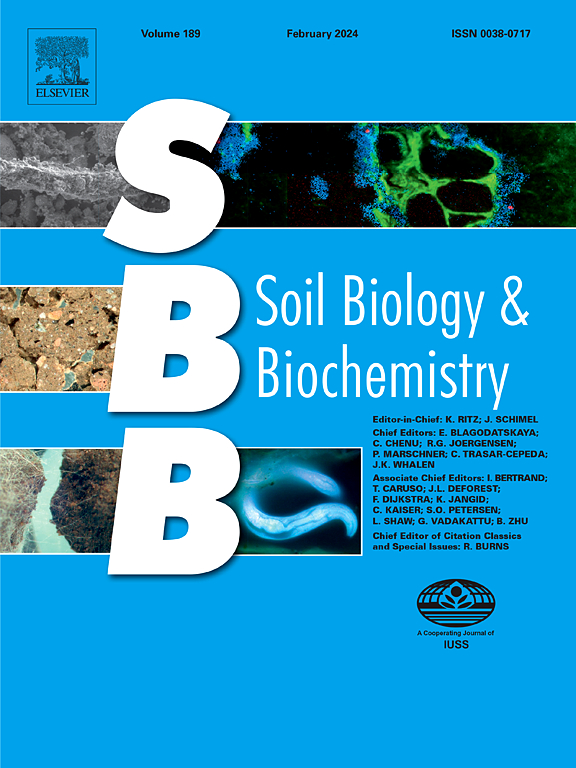Soil viral community dynamics over seven years of heat disturbance: Spatial variation exceeds temporal in annually sampled soils
IF 9.8
1区 农林科学
Q1 SOIL SCIENCE
引用次数: 0
Abstract
Viruses are important components of the soil microbiome, influencing microbial population dynamics and the functions of their hosts. However, the relationships and feedbacks between virus dynamics, microbial host dynamics, and environmental disturbance are not understood. Centralia, PA, USA, is the site of an underground coal seam fire that has been burning for over 60 years. As the fire moves along the coal seam, previously heated soils cool to ambient temperature, creating a gradient of heat disturbance intensity and recovery. We examined annual soil viral population dynamics over seven consecutive years in Centralia using untargeted metagenome sequencing. Viral communities changed over time and were distinct between fire-affected and reference sites. Dissimilarity in viral communities was greater across sites (space) than within a site across years (time), and cumulative viral diversity more rapidly stabilized within a site across years than within a year across sites. There also were changes in number of CRISPR arrays per genome as soils cooled, corresponding to shifts in viral diversity. Finally, there were also differences in viral-encoded auxiliary metabolic genes between fire-affected and reference sites. Thus, despite high site-to-site soil viral diversity, there was surprising viral community consistency within a site over the years and shifting host-viral interactions in soils recovering from disturbance. Overall, this work provides insights into the interannual dynamics of soil viruses and their host communities, as well as how they collectively respond to long-term warming.
热扰动7年土壤病毒群落动态:年样土壤空间变化超过时间变化
病毒是土壤微生物组的重要组成部分,影响着微生物种群动态及其宿主的功能。然而,病毒动力学、微生物宿主动力学和环境扰动之间的关系和反馈尚不清楚。美国宾夕法尼亚州森特勒利亚是一个地下煤层火灾的地点,已经燃烧了60多年。当火沿着煤层移动时,先前加热的土壤冷却到环境温度,产生热扰动强度和恢复的梯度。我们使用非靶向宏基因组测序方法连续7年检测了Centralia地区的年度土壤病毒种群动态。病毒群落随着时间的推移而变化,并且在受火灾影响的地点和参考地点之间存在明显差异。病毒群落在不同地点(空间)之间的差异大于同一地点在不同年份(时间)之间的差异,并且在同一地点内,累积的病毒多样性在不同年份内比在不同地点之间的一年内更迅速地稳定下来。随着土壤变冷,每个基因组的CRISPR阵列数量也发生了变化,这与病毒多样性的变化相对应。最后,在受火灾影响的位点和参考位点之间,病毒编码的辅助代谢基因也存在差异。因此,尽管站点间土壤病毒多样性很高,但多年来在一个站点内存在令人惊讶的病毒群落一致性,并且在从干扰中恢复的土壤中发生了宿主-病毒相互作用的变化。总的来说,这项工作提供了对土壤病毒及其宿主群落的年际动态的见解,以及它们如何集体应对长期变暖。
本文章由计算机程序翻译,如有差异,请以英文原文为准。
求助全文
约1分钟内获得全文
求助全文
来源期刊

Soil Biology & Biochemistry
农林科学-土壤科学
CiteScore
16.90
自引率
9.30%
发文量
312
审稿时长
49 days
期刊介绍:
Soil Biology & Biochemistry publishes original research articles of international significance focusing on biological processes in soil and their applications to soil and environmental quality. Major topics include the ecology and biochemical processes of soil organisms, their effects on the environment, and interactions with plants. The journal also welcomes state-of-the-art reviews and discussions on contemporary research in soil biology and biochemistry.
 求助内容:
求助内容: 应助结果提醒方式:
应助结果提醒方式:


